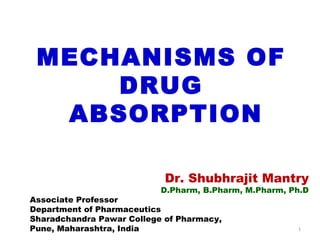
MECHANISMS OF DRUG ABSORPTION
- 1. 1 MECHANISMS OF DRUG ABSORPTION Dr. Shubhrajit Mantry D.Pharm, B.Pharm, M.Pharm, Ph.D Associate Professor Department of Pharmaceutics Sharadchandra Pawar College of Pharmacy, Pune, Maharashtra, India
- 2. MECHANISMS OF DRUG ABSORPTION 2 The three broad categories are 1.Transcellular/intracellular transport 2.Paracellular/Intercellular Transport 3.Vesicular or Corpuscular Transport (Endocytosis)
- 3. 3 1. Transcellular/intracellular transport : It is defined as the passage of drugs across the GI epithelium. 3 steps involved –Permeation of GI epithelial cell membrane –Movement across the intracellular space (cytosol). –Permeation of the lateral or basolateral membrane. The various transcellular transport processes involved in drug absorption are – • Primary active transport • Secondary active transport (Symport & Antiport) • Passive diffusion • Pore Transport • Ion-Pair Transport • Facilitated Diffusion B. Active Transport processA. Passive Transport Processes
- 4. 4 A. Passive Transport Processes – These transport processes do not require energy other than that of molecular motion (Brownian motion) to pass through the lipid bilayer. Passive transport processes can be further classified into following types – –Passive diffusion. –Pore transport. –Ion-pair transport. –Facilitated- or mediated-diffusion.
- 5. Passive Diffusion Also called non-ionic diffusion, it is the major process for absorption of more than 90% of the drugs. It is defined as the difference in the drug concentration on either side of the membrane Passive diffusion is best expressed by Fick’s first law of diffusion, which states that the drug molecules diffuse from a region of higher concentration to one of lower concentration until equilibrium is attained and that the rate of diffusion is directly proportional to the concentration gradient across the membrane. ( )C-C h DAK dt dQ GIT m/w = 5 Adolf Eugen Fick
- 6. 6
- 7. Ion-Pair Transport 7 Absorption of drugs like quaternary ammonium compounds (+) and sulphonic acids (-), which ionise (convert into molecules) under all pH conditions is known as ion-pair transport. Such neutral complexes have both the required lipophilicity as well as aqueous solubility for passive diffusion. Such a phenomenon is called as ion-pair transport. Propranolol, a basic drug that forms an ion pair with oleic acid, is absorbed by this mechanism. Ion-pair transport of a cationic drug
- 8. Facilitated Diffusion • It is a carrier-mediated transport system that operates down the concentration gradient (downhill transport) but at a much a faster rate than can be accounted by simple passive diffusion. • The driving force is concentration gradient (hence a passive process). Since no energy expenditure is involved, the process is not inhibited by metabolic poisons that interfere with energy production. Facilitated diffusion of vitamin B12 8
- 9. 9 Figure: Comparison of rate of absorption vs. drug concentration plots for passive and carrier-mediated transport process.
- 10. 10 B. Active Transport Processes This transport process requires energy from ATP (Adenosine triphosphate) to move drug molecules from extracellular to intracellular. These are of two types – A. Primary active transport. B. Secondary active transport – this process is further subdivided into two types: I. Symport (co-transport). II. Antiport (counter-transport). Adenosine triphosphate (ATP) is a complex organic chemical that provides energy to drive many processes in living cells, e.g. muscle contraction, nerve impulse propagation, and chemical synthesis.
- 11. 11 Primary active transport – In this process, there is direct ATP requirement. Moreover, the process transfers only one ion or molecule and in only one direction, and hence called as uniporter e.g. absorption of glucose.
- 12. 12 Secondary active transport – In these processes, there is no direct requirement of ATP i.e. it takes advantage of previously existing concentration gradient. The energy required in transporting an ion aids transport of another ion or molecule (co-transport or coupled transport) either in the same direction or in the opposite direction. Accordingly this process is further subdivided into: a. symport (co-transport) – involves movement of both molecules in the same direction e.g. Na+ -glucose symporter b. Antiport (counter-transport) – involves movement of molecules in the opposite direction e.g. H+ ions using the Na+ gradient in the kidneys.
- 13. 13 Figure: TYPES OF ACTIVE TRANSPORT
- 14. 14
- 15. 15 B. PARACELLULAR / INTERCELLULAR TRANSPORT It is defined as the transport of drugs through the junctions between the GI epithelial cells. The two paracellular transport mechanisms involved in drug absorption are: Permeation through tight junctions of epithelial cells This process basically occurs through openings which are little bigger than the aqueous pores. Compounds such as insulin and cardiac glycosides are taken up this mechanism. Persorption It is permeation of drug through temporary openings formed by shedding (entering) of two neighbouring epithelial cells into the lumen.
- 16. 16 C. Vesicular or Corpuscular Transport (Endocytosis) It is a minor transport mechanism which involves engulfing extracellular materials within a segment of the cell membrane to form a vesicle. Hence this is also called as vesicular transport or endocytosis. Vesicular transport of drugs can be classed into two categories : Phagocytosis (cell eating): adsorptive uptake of solid particulates, and Pinocytosis (cell drinking): uptake of fluid solute.
- 17. 17 THANK YOU
